
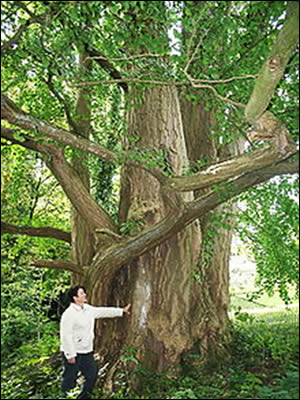
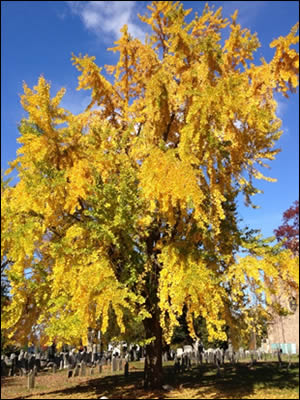
Ginkgos are large trees, normally reaching a height of 20 – 35m with some specimens in China being over 50m. The tree has an angular crown and long, somewhat erratic branches. It is usually deep rooted and resistant to wind and snow damage. Young trees are often tall and slender and sparsely branched; the crown becomes broader as the tree ages. During autumn, the leaves turn a bright yellow, then fall very rapidly. A combination of resistance to disease, insect-resistant wood and the ability to form aerial roots and sprouts makes ginkgos long-lived, with some specimens claimed to be more than 2,500 years old.
Ginkgo is a relatively shade-intolerant species that grows best when well-watered and well-drained. Ginkgo branches grow in length by growth of shoots with regularly spaced leaves. From the axils of these leaves, "spur shoots" develop on second-year growth. Short shoots have very short internodes; they may grow only one or two centimetres in several years. Their leaves are usually not lobed. They are short and knobby, and are arranged regularly on the branches except on first-year growth. Because of the short internodes, leaves appear to be clustered at the tips of short shoot
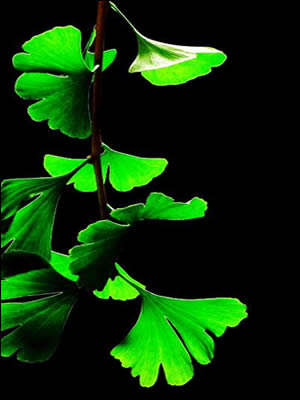
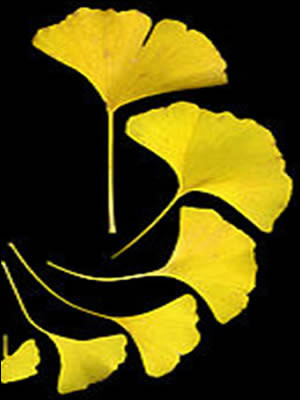
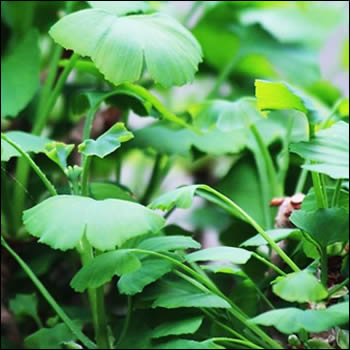
The leaves are unique among seed plants, being fan-shaped with veins radiating out into the leaf blade, sometimes bifurcating (splitting), but never anastomosing to form a network. They grow more rapidly on the growing tips, where they are alternate and spaced out, and also on the short, stubby spur shoots where they are clustered at the tips.
Ginkgos are popular subjects for growing both as penjing and bonsai. They can be kept artificially small and tended over centuries. Ginkgo has long been cultivated in China; some planted trees at temples are believed to be over 1,500 years old. The first record of Europeans encountering them is in 1690 in Japanese temple gardens.
- Prune new growth throughout growing season, cutting back branches in autumn after the leaves have dropped.
- They do not callus over cuts and heal; large cuts should be avoided particularly those at the front of the tree.
- Ginkgos as bonsai tend to be a very upright form, therefore are a natural for an informal upright style. They are conical when young but develop a broader crown with the development of branches.
- To prune your Ginkgo bonsai just cut back overly long branches to keep the tree in balance. Its natural shape is a good style, or even it’s only style.
The large leaves and rather stiff thick branches make it suitable for medium to large size trees; reducing leaf size is slow and difficult creating a broom-like style with the top an even pointed shape (like a candle flame). In addition they make a good twin trunk, raft, clump or sinuous style. Some Ginkgos produce aerial roots, known as ‘Chichi Icho’ (Japanese “nipples” or “breast”). These form on the undersides of large branches and grow downwards. The growth of ‘chi’ is very slow and may take hundreds of years to develop. The function of these thick aerial roots is currently unknown but they are a desirable feature for bonsai.
Ginkgo biloba: ‘Autumn Gold’ – Tree sized, upright habit, long lasting autumn colour is the most commonly used variety for bonsai purposes.
Protect the roots during winter frosts; the roots have a high moisture content and can burst if temperatures go below -5°C. In the ground this would not happen as the roots go deeply down to levels that do not freeze except in areas of permafrost.
They tend to need repotting annually; do this in early spring until ten years old, then every second year using basic soil mix, while for mature trees repot every three years. They tend to like a fine silty mix with good drainage and a Ph range of 5.0 - 5.5.
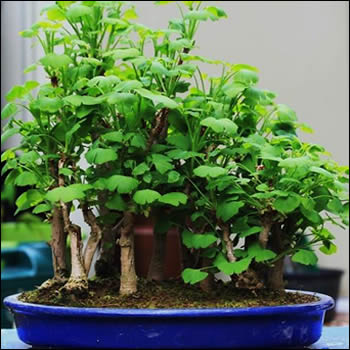
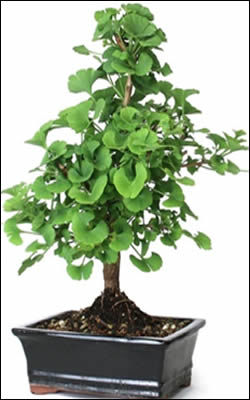
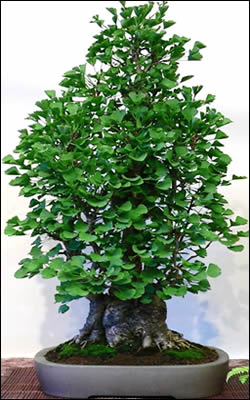
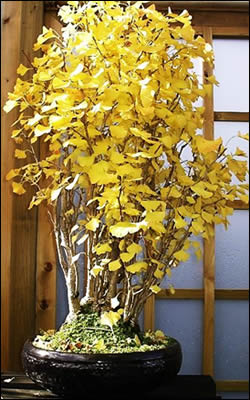

Web design: nysys